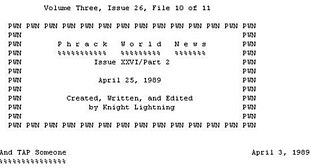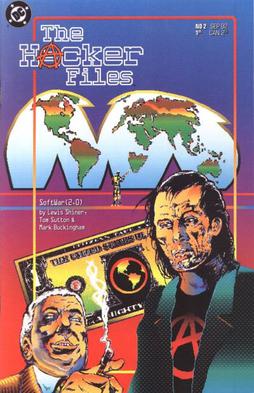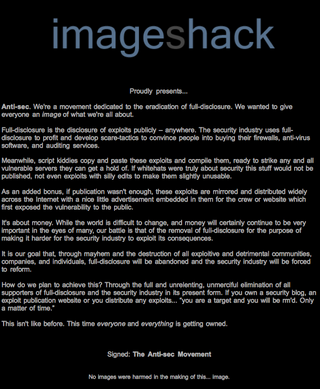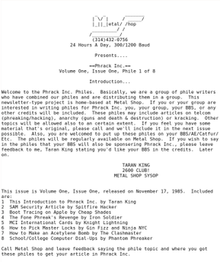
2600: The Hacker Quarterly is an American seasonal publication of technical information and articles, many of which are written and submitted by the readership, on a variety of subjects including hacking, telephone switching systems, Internet protocols and services, as well as general news concerning the computer "underground."

Karl Werner Lothar Koch was a German hacker in the 1980s, who called himself "hagbard", after Hagbard Celine. He was involved in a Cold War computer espionage incident.
Gray Areas was a quarterly magazine published from 1992 to 1995 by publisher Netta Gilboa. The magazine was based in Phoenix, Arizona. It won several awards including "One Of The Top Ten Magazines of 1992" by Library Journal. It discussed subcultures involving drugs (narcotics), phreaking, cyberpunk, pornography, the Grateful Dead and related issues. It only published 7 issues, but continues on as a website.
The Conscience of a Hacker is a short essay written on January 8, 1986 by Loyd Blankenship, a computer security hacker who went by the handle The Mentor, and belonged to the second generation of hacker group Legion of Doom.
Loyd Blankenship, better known by his pseudonym The Mentor, is an American computer hacker and writer. He has been active since the 1970s, when he was a member of the hacker groups Extasyy Elite and Legion of Doom.
Operation Sundevil was a 1990 nationwide United States Secret Service crackdown on "illegal computer hacking activities." It involved raids in approximately fifteen different cities and resulted in three arrests and the confiscation of computers, the contents of electronic bulletin board systems (BBSes), and floppy disks. It was revealed in a press release on May 9, 1990. The arrests and subsequent court cases resulted in the creation of the Electronic Frontier Foundation. The operation is now seen as largely a public-relations stunt. Operation Sundevil has also been viewed as one of the preliminary attacks on the Legion of Doom and similar hacking groups. The raid on Steve Jackson Games, which led to the court case Steve Jackson Games, Inc. v. United States Secret Service, is often attributed to Operation Sundevil, but the Electronic Frontier Foundation states that it is unrelated and cites this attribution as a media error.
Chris Goggans is an American hacker, a founding member of the Legion of Doom group, and a former editor of Phrack magazine. He is known as an expert in security as well as for his statements on hacker ethics and responsibility.

Craig Neidorf, a.k.a.Knight Lightning, was one of the two founding editors of Phrack Magazine, an online, text-based ezine that defined the hacker mentality of the mid 1980s.

Hugi is one of the longest lasting, frequently released demoscene and underground disk magazines (diskmag) for IBM-PC.

Bruce Fancher is a former computer hacker and member of the Legion of Doom hacker group. He co-founded MindVox in 1991 with Patrick K. Kroupa.

The Hacker Crackdown: Law and Disorder on the Electronic Frontier is a work of nonfiction by Bruce Sterling first published in 1992.
Summercon is one of the oldest hacker conventions, and America's oldest and longest-running information security conference. It helped set a precedent for more modern "cons" such as H.O.P.E. and DEF CON, although it has remained smaller and more personal. Summercon has been hosted in cities such as Pittsburgh, St. Louis, Atlanta, Washington, D.C., New York City, Austin, Las Vegas, and Amsterdam. Originally run by Phrack, the underground ezine, and held annually in St. Louis, the organizational responsibilities of running Summercon were transferred to clovis in 1998 and the convention took place in Atlanta, dubbed 'Summercon X'.
Electron was the computer handle of Richard Jones, a member of an underground hacker community called The Realm. Jones, born in June 1969, was one of three members of the group arrested in simultaneous raids by the Australian Federal Police in Melbourne, Australia, on 2 April 1990. All three — Nahshon Even-Chaim, Electron and Nom — were convicted of a range of computer crimes involving the intrusion into US defense and government computer systems and the theft of an online computer security newsletter in the late 1980s and early 1990.

The Hacker Files is a twelve issue DC Comics mini-series published from August 1992 to July 1993. It was written by Lewis Shiner and illustrated by Tom Sutton.
The Computer Underground Digest (CuD) was a weekly online newsletter on early Internet cultural, social, and legal issues published by Gordon Meyer and Jim Thomas from March 1990 to March 2000.
Leonard Rose, aka Terminus, is an American hacker who in 1991 accepted a plea bargain that convicted him of two counts of wire fraud stemming from publishing an article in Phrack magazine.

The Anti Security Movement is a movement opposed to the computer security industry. Antisec is against full disclosure of information relating to software vulnerabilities, exploits, exploitation techniques, hacking tools, attacking public outlets and distribution points of that information. The general thought behind this is that the computer security industry uses full disclosure to profit and develop scare-tactics to convince people into buying their firewalls, anti-virus software and auditing services.
Patrick Karel Kroupa is an American writer, hacker and activist. Kroupa was a member of the Legion of Doom and Cult of the Dead Cow hacker groups and co-founded MindVox in 1991, with Bruce Fancher. He was a heroin addict from age 14 to 30 and got clean through the use of the hallucinogenic drug ibogaine.

In United States v. Riggs, the government of the United States prosecuted Robert Riggs and Craig Neidorf for obtaining unauthorized access to and subsequently disseminating a file held on BellSouth's computers. The file, referred to as the E911 file, gave information regarding BellSouth's products implementing 911 emergency telephone services. Riggs and Neidorf were both indicted in the District Court of the Northern District of Illinois on numerous charges relating to the dissemination of the E911 text file. As Riggs had previously been indicted in the Northern District of Georgia in relation to the same incident, his charges from Illinois were transferred to Georgia. Riggs ultimately pleaded guilty in Georgia and was sentenced to 21 months in prison and two years' supervised release. Neidorf pleaded not guilty in Illinois and the government dropped all charges against Neidorf four days after the trial began.
Plover-NET, often misspelled Plovernet, was a popular bulletin board system in the early 1980s. Hosted in New York state and originally owned and operated by a teenage hacker who called himself Quasi-Moto, whom was a member of the short lived yet famed Fargo 4A phreak group. The popular bulletin board system attracted a large group of hackers, telephone phreaks, engineers, computer programmers, and other technophiles, at one point reaching over 600 users until LDX, a long distance phone company, began blocking all calls to its number (516-935-2481).














